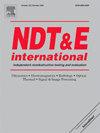预浸纤维波纹度检测涡流探头的建模与实验评价
IF 4.5
2区 材料科学
Q1 MATERIALS SCIENCE, CHARACTERIZATION & TESTING
引用次数: 0
摘要
尽管在制造过程中为实现未固化碳纤维的在线检测做出了许多努力,但标准的无损检测方法尚未满足这一挑战。高强度涡流由8字形的细长发射器线圈产生,沿着碳纤维的路径,使光纤波纹可视化。采用一种新颖的有限元建模方法,精确模拟了由表面波动引起的电流密度畸变。为了验证所提出的有限元方法,本文给出了优化定向涡流测试(ECT)探头的实验结果,用于检测碳纤维预浸料顶部表面的面内波浪度,并讨论了应用挑战。本研究通过调整不同长宽比的接收线圈之间的角度,探索了六种ECT探头的创建。进行灵敏度评估以检查探针在检测感兴趣的纤维特征方面的能力。结果表明,所选择的探头设计具有矩形接收器,接收器之间的相对角度为10度,能够在线检测目标缺陷,信噪比(SNR)超过70。测试了最大1mm的不同升降距离对所选探针对目标缺陷的灵敏度的影响,观察到最佳灵敏度约为0.6 mm,信噪比超过6。本文章由计算机程序翻译,如有差异,请以英文原文为准。
Modeling and experimental evaluation of eddy-current probes for prepreg fiber waviness inspection
Despite numerous efforts to achieve in-line inspection of uncured carbon fiber during manufacturing, standard non-destructive testing methods have yet to meet this challenge. High-intensity eddy currents generated by a figure-8 shaped elongated transmitter coil follow the paths of carbon fibers, enabling visualization of fiber waviness. An innovative finite element modeling (FEM) approach was implemented for precise simulation of current density distortions caused by surface waviness. To validate the proposed FEM method, this paper presents experimental findings on optimizing a directional eddy current testing (ECT) probe to detect in-plane waviness at the top surface of carbon fiber prepreg, along with a discussion of application challenges. This study explores the creation of six ECT probes by adjusting the angle between receiver coils of varying aspect ratios. Sensitivity assessments were conducted to examine the probe's capabilities in detecting fiber features of interest. The results indicate that the selected probe design, featuring rectangular receivers and a 10-degree relative angle between receivers, is capable of in-line inspection of targeted defects with a signal-to-noise ratio (SNR) exceeding 70. The effects of varying lift-off distance up to 1 mm on the selected probe's sensitivity to targeted defects were examined, with optimal sensitivity observed at approximately 0.6 mm and a SNR exceeding 6.
求助全文
通过发布文献求助,成功后即可免费获取论文全文。
去求助
来源期刊

Ndt & E International
工程技术-材料科学:表征与测试
CiteScore
7.20
自引率
9.50%
发文量
121
审稿时长
55 days
期刊介绍:
NDT&E international publishes peer-reviewed results of original research and development in all categories of the fields of nondestructive testing and evaluation including ultrasonics, electromagnetics, radiography, optical and thermal methods. In addition to traditional NDE topics, the emerging technology area of inspection of civil structures and materials is also emphasized. The journal publishes original papers on research and development of new inspection techniques and methods, as well as on novel and innovative applications of established methods. Papers on NDE sensors and their applications both for inspection and process control, as well as papers describing novel NDE systems for structural health monitoring and their performance in industrial settings are also considered. Other regular features include international news, new equipment and a calendar of forthcoming worldwide meetings. This journal is listed in Current Contents.
 求助内容:
求助内容: 应助结果提醒方式:
应助结果提醒方式:


